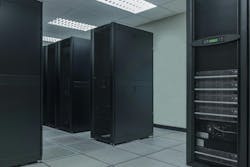Businesses are piloting AI and machine learning use cases that show promising results for delivering value. Yet many are quickly realizing that the benefits carry significant dependencies — namely, power management — that must be addressed before AI can truly deliver on its expectations.
Power system engineers now face greater urgency to design data center power systems that can help support the increasing consumption from AI workloads while maintaining their focus on ever-present needs like resiliency and sustainability. Emerging innovations in data center infrastructure can help engineers rethink power management to balance these demands and meet the needs of AI innovation.
Considering the grey space
Grey space solutions are essential to distribute power throughout the data center and ensure uptime during unplanned power events. Whether building a new, AI-ready data center or upgrading existing infrastructure, engineers should consider emerging innovations to help meet the demands of AI and other advancing trends, including:
- Uninterruptible power supplies (UPSs). The UPS is the cornerstone of power protection in the data center and serves as the bridge to generator power during an unplanned outage. Growing power demands and the need for more IT infrastructure (such as GPUs, servers, and storage) have paved the way for UPSs that are more efficient and provide higher power density in a smaller footprint. Additionally, UPSs now offer greater flexibility in available battery technology and chemistry as well as the ability to deploy new systems quickly to meet the rapid demand for scalability.
For engineers seeking to modernize existing infrastructure (rather than replace what already exists) some manufacturers offer modernization programs that allow the installation of new and improved electronics and batteries into the frame of the existing UPS. This can be an attractive option for those who have aging equipment and need to upgrade quickly without fully replacing installed systems.
- Medium-voltage switchgear. Medium-voltage switchgear provides centralized control and protection of medium-voltage power equipment in the data center involving generators, motors, feeder circuits and transmission, and distribution lines. These technologies help protect personnel from arc faults on both grounded and ungrounded systems.
When deploying a new unit, engineers should look for advanced solutions that offer enhanced safety and operating features, maintenance-free medium-voltage compartments, smaller footprints, superior ratings, and the ability to meet both IEEE C37.20.9 and IEC 62271-200 safety standards. Some newer medium-voltage switchgear solutions can adapt to handle different voltages without requiring replacement, providing critical flexibility in an era of dynamic energy demands.
- Molded-case circuit breakers. Circuit breaker technology continues to advance in its ability to keep employees and other personnel safe from arc flash events, and emerging solutions are available in smaller footprints for easy adaptability regardless of the application or requirement. Recent innovations in circuit breaker technology include trip units that incorporate digitalization, giving users the ability to monitor breaker health and thermal status in real time.
Trip units are also embedded with communications and metering to reduce costs and push actionable data through power distribution monitoring and control. Using these advancements, data centers can generate data to help optimize performance and power consumption and use predictive diagnostics to uncover, diagnose, and stop power outages before they happen.
- Floor power distribution. Floor standing or cabinet power distribution units (PDUs) are often used in raised and non-raised floor applications to take incoming power and distribute it to an individual rack or groups of racks. These systems optimize power utilization and availability down to the branch circuit level. They also address needs for isolation, voltage transformation, harmonic reduction, and voltage regulations, while offering unique monitoring and diagnostic capabilities to help facilitate load balancing and warn of potential threats. Because of the changing power needs driven by AI at the rack level as well as other innovations, cabinet PDU technology continues to evolve with higher levels of flexibility and configurability, allowing engineers to design systems that meet their unique requirements.
- Battery energy storage. Containerized battery energy storage systems enable data centers to store energy so it can be used on demand as a backup power source, help offset peak usage to lower costs, or even participate in selling energy back to the grid. These systems can also be used to maximize the consumption of renewable energy that is locally produced to power buildings or charge electric vehicles.
Powering the white space
The white space — comprising IT-supporting equipment, such as servers, storage and networking equipment, racks, and cooling systems — will see ongoing transformation as businesses invest in new infrastructure to support generative AI. Power management technology is advancing to help ensure the resiliency, safety, security, and sustainability of these critical systems. Important technologies to consider include:
- Lithium-Ion batteries. In recent years, lithium-ion battery technology has become an attractive alternative to traditional valve-regulated lead-acid (VRLA) batteries in UPSs supporting critical IT equipment. Among other benefits, lithium-ion can deliver higher power density in a smaller footprint without compromising essential backup runtime requirements. Additionally, the extended runtime of lithium-ion technology can help reduce the frequency of required maintenance.
- IT rack enclosures. The IT rack can help organize and secure IT equipment in everything from high-density data centers to edge environments. Newer enclosures are emerging in the market that are purpose-built to support larger, heavier AI servers and critical IT infrastructure. These racks offer higher weight capacities, deeper enclosures, and different designs for better visibility in high-density environments as well as the ability to accommodate alternative cooling methods, such as liquid cooling.
- Rack power distribution. Rack PDUs have advanced significantly with new features that can help save time, reduce costs, and simplify power management. Examples of recent innovations in rack PDU technology include higher power densities, with PDUs that pack more outlets into the same amount of space, including outlets that accommodate higher amperages; universal input, enabling engineers to deploy a single PDU SKU across a global data center network without having to mix and match PDUs to serve multiple locations; and network connectivity, allowing for remote monitoring and management of power at the rack level.
As with UPSs, some manufacturers now offer the opportunity to retrofit existing PDUs with modern equipment inside an existing PDU frame, eliminating the need to replace current PDUs wholesale as needs change.
- Liquid cooling. The amount of heat generated by data center infrastructure will grow exponentially as data centers invest in higher-density infrastructure to support generative AI, such as GPUs, servers, and storage. This will require engineers to explore innovative approaches to traditional, fan-driven cooling systems. One promising trend that has emerged is liquid cooling, which improves heat transfer using dielectric fluids.
Currently, two types of liquid cooling show great promise. Direct-to-chip cooling uses specialized liquid to extract heat at the source (i.e., directly in contact with CPUs and GPUs). Immersion cooling requires full submersion of the server in nonconducting, dielectric fluids, which helps improve the overall efficiency of cooling. Both of these options offer distinct advantages and will be imperative as data centers experience higher power requirements through the proliferation of GPU servers.
Because liquid cooling is nascent in its evolution and many data centers may not be equipped to adopt certain approaches, engineers seeking to modernize may determine that a hybrid approach that uses air and liquid cooling is best to meet current needs while they explore new innovations.
- Track busway. A structured track busway system can distribute power safely and reliably within the data center and offers multiple advantages over traditional cable and conduit. Modern track busway systems provide high-speed monitoring, key electrical performance metrics, and proactive management of power usage and availability.
Additionally, these systems have evolved to offer considerable flexibility and configurability — both essential considerations in modernizing and future-proofing data centers to support emerging innovations. For example, modern track busway systems can include a multitude of features, such as tap-off boxes that are easily adapted to different layouts, with multi-range ampacity buses to support a wide range of power loads without requiring replacement.
From energy users to energy producers
As data centers expand computing infrastructure to meet rising power requirements, many are realizing that the existing energy grid may not be capable of sustaining their growing needs. Additionally, data centers must prepare for more frequent outages and disturbances — as grid reliability may be compromised by escalating demand and an increasing reliance on renewable energy sources.
In short, there is now growing industry awareness that it is no longer enough for data centers to simply be consumers of energy. They must become energy producers.
As we have explored, deploying UPSs and battery energy storage systems with lithium-ion battery technology can help extend service life and offer higher power density in a smaller footprint, reserving room for new infrastructure to better support AI. Compared to traditional VRLA batteries, lithium-ion batteries provide longer battery life and faster recharge capabilities as well.
An additional, key advantage of lithium-ion batteries, especially as sustainability demands rise, is their inherent energy storage capabilities. When combined with intelligent energy management, data analytics, and sophisticated controls, a lithium-ion battery-powered UPS can be transformed into a distributed energy resource (DER), enabling a bi-directional flow of energy to and from the grid. This approach allows data centers to more efficiently and effectively coordinate multiple energy sources, anticipate energy needs, and participate in grid programs to earn new revenue streams. Utilizing this approach can help curtail peak power draw from the utility, reducing costly demand charges and helping advance sustainability goals.
Deploying a full-scale microgrid is another promising strategy to enhance energy resilience, reduce grid dependence, advance islanding capabilities, and optimize energy usage. Microgrids offer reliable backup power during unexpected outages by balancing fluctuations in energy demand and consumption. By leveraging microgrid technology, data centers can better support the integration of renewable energy sources like solar and battery energy storage, further reducing energy costs and boosting resiliency.
Progress with a purpose
As the landscape for data centers continues to evolve, generative AI will transform the industry and require investment in new solutions and approaches to power management. By understanding available solutions for both the grey space and white space — as well as exploring innovative approaches to meeting grid power availability challenges — engineers can support the AI innovation needs of today while preparing to meet the resiliency and sustainability opportunities of tomorrow.
About the Author

Forrest Secosky
Forrest Secosky is the commercial marketing manager for Data Centers at Eaton in Raleigh, North Carolina. Prior to this role, he was the strategic lead for Modular Solutions including substations, data centers, power assemblies, and nova reclosers.

